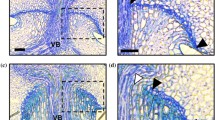Abstract
Yayoi-murasaki is a traditional black sticky rice cultivar, which has long been grown locally in Tokushima prefecture in Japan for celebratory or religious occasions. This cultivar is characterized by late heading and easy seed shattering habits compared with modern Japanese rice cultivars, resulting in low yield performance. Severe seed shattering has been the major concern, especially under typhoon attacks. Therefore, mutant breeding using γ-ray was undertaken to mitigate seed shattering trait. Several lines selected for reduced seed shattering exhibited various phenotypes for seed shattering, fertility, and panicle morphology. These lines are a good resource for the improvement of Yayoi-murasaki and can be useful to understand the molecular mechanism of seed shattering trait in rice.






Similar content being viewed by others
References
Akasaka M, Konishi S, Izawa T, Ushiki J. Histological and genetic characteristics associated with the seed-shattering habit of weedy rice (Oryza sativa L.) from Okayama, Japan. Breed Sci. 2011;61:p168–73.
Hofmann NR. SHAT1, a new player in seed shattering of rice. Plant Cell. 2012;24:839.
Htun TM, Inoue C, Chhourn O, Ishii T, Ishikawa R. Effect of quantitative trait loci for seed shattering on abscission layer formation in Asian wild rice Oryza rufipogon. Breed Sci. 2014;64:199–205.
Izawa T, Mihara M, Suzuki Y, Gupta M, Itoh H, Nagano AJ, et al. Os-GIGANTEA confers robust diurnal rhythms on the global transcriptome of rice in the field. Plant Cell. 2011;23:1741–55.
Konishi S, Izawa T, Lin SY, Ebana K, Fukuta Y, Sasaki T, et al. An SNP caused loss of seed shattering during rice domestication. Science. 2006;312:1392–6.
Li C, Zhou A, Sang T. Rice domestication by reducing shattering. Science. 2006;311:1936–9.
Oikawa T, Maeda H, Oguchi T, Yamaguchi T, Tanabe N, Ebana K, et al. The birth of a black rice gene and its local spread by introgression. Plant Cell. 2015;27:2401–14.
Yoon J, Cho LH, Kim SL, Choi H, Koh HJ, An G. The BEL1-type homeobox gene SH5 induces seed shattering by enhancing abscission-zone development and inhibiting lignin biosynthesis. Plant J. 2014;79:717–28.
Zhou Y, Lu D, Li C, Luo J, Zhu BF, Zhu J, et al. Genetic control of seed shattering in rice by the APETALA2 transcription factor SHATTERING ABORTION1. Plant Cell. 2012;24:1034–48.
Acknowledgments
This work was supported in part by a Grant-in Aid (No. 23780006 to S. KS.) from Japanese Society for Promotion of Science.
Author information
Authors and Affiliations
Corresponding author
Rights and permissions
About this article
Cite this article
Tada, N., Nii, K. & Konishi-Sugita, S. Mutant breeding of a Japanese traditional black rice cultivar Yayoi-murasaki to improve seed shattering trait. Nucleus 58, 217–223 (2015). https://doi.org/10.1007/s13237-015-0155-y
Received:
Published:
Issue Date:
DOI: https://doi.org/10.1007/s13237-015-0155-y




